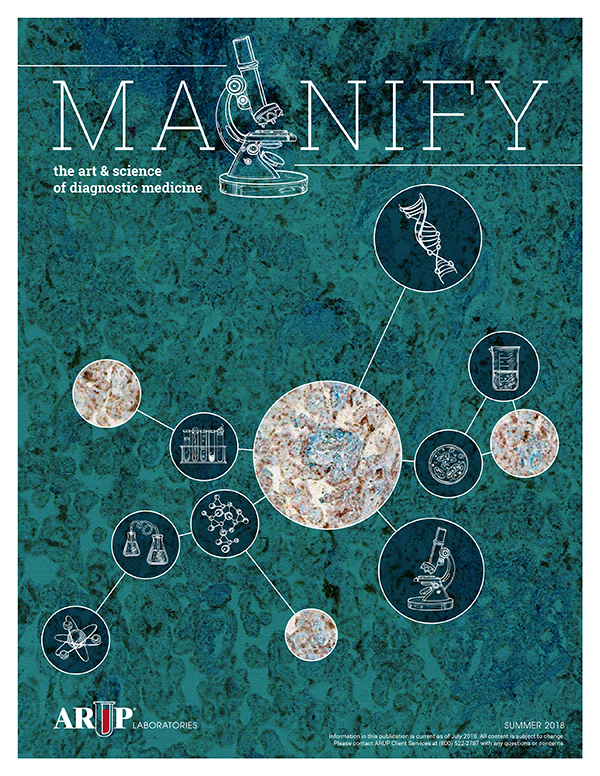ARUP’s Growth and Ethos Over a Span of 37 Years
Today, ARUP owns eight buildings in Research Park that include more than 65 labs and encompass 750,000 square feet of physical space. Unlike many national reference laboratories, ARUP has intentionally kept most of its nearly 4,800 employees and labs centralized in one location.
“As we’ve grown, a guiding principle has always been how to remain centralized. We have seen how other reference laboratories that are spread out across the country are fraught with problems involving lost specimens,” President Andy Theurer said. “It is a competitive advantage to have testing in one place, and it also allows for in-person collaboration among our experts.”
ARUP Moves to Research Park
ARUP, a small, entrepreneurial startup, moves its operations out of the University of Utah Hospital and leases a 25,000-square-foot building in Research Park
ARUP’s 1984 move to Research Park was noted in a Salt Lake Tribune article quoting John Matsen, MD, then chairman of the University of Utah Department of Pathology, as stating that cluster labs that performed tests for other medical facilities weren’t new, but that no other medical school he knew of operated this type of lab.
Legacy Building Takes Shape
ARUP builds a new 75,000-square-foot building in Research Park that houses the entire company. Additional space allows ARUP to recruit medical faculty to run additional specialized labs with room for large-scale instrumentation.
Second Building Added
A large amount of lab and office space, 136,000 square feet, is added to the Legacy Building. This becomes known as Building 2.
By the mid-1990s, nearly two-thirds of the nation’s leading academic medical centers are sending samples to ARUP, and the company’s labs begin operating 24/7.
Universities from around the country came to study ARUP to see if they could accomplish the same objectives with their own departments of pathology but ultimately found insufficient will in their institutions to proceed. “The real value of ARUP is the intellectual know-how of its medical directors and their teams,” said ARUP cofounder Carl Kjeldsberg, MD. “A lot of people can buy instruments and start testing. ARUP is more than that.”
Lab Stewardship Introduced
ARUP introduces the Analyzing Test Ordering Patterns (ATOP) report, a pioneering step in lab stewardship.
Specimens
Third Building Added
“The addition of Building 3 [72,000 square feet of space] allowed for optimal specimen flow throughout ARUP’s operations. We methodically organized labs so that those with higher volumes and more specimen touches were placed closer to the specimen processing area—the heart of preanalytical operations—and labs with lower volumes were positioned further out,” said David Rogers, senior operations director.
ARUP acquires a nucleic acid sequencer, allowing for the development of the original Hepatitis C Genotype test, which becomes one of ARUP’s most successful tests over the next two decades.
Specimens
Institute for Learning Established
The Institute for Learning is established to deliver education to employees and ARUP clients.
Early 2000s: ARUP acquires its first tandem mass spectrometer (TMS), which allows for the development of the original methylmalonic acid test and lays the foundation for the hundreds of TMS tests that have followed since.
Specimens
Legacy Building Expanded
A 42,000-square-foot expansion is added to the Legacy Building. This additional space allows for a larger specimen processing area, an enormous, robotic-operated freezer that can hold 2.2 million specimens, and a cafeteria for employees.
Specimens
Lab Automation Improves
A new lab automation system—10 times the size of an average hospital’s automation system—is installed. It transports and sorts up to 4,000 specimen tubes per hour and is capable of doubling that rate as ARUP expands.
Specimens
ARUP Consult Launched
“We are an academic medical lab, and Consult was a way to share our expertise and evidence-based guidance beyond the lab and with the broader diagnostic world,” said Brian Jackson, MD, medical director of Support Services, IT, and Business Development.
Mid to late 2000s: Cytokine testing capability is developed using Luminex fluorescent bead technology. Unbeknownst to the company at the time, this expertise would prepare ARUP for the high influx of cytokine testing during the COVID-19 pandemic.
Specimens
More Buildings Acquired
2008: Building 560 is acquired.
2009: Building 606 is acquired.
These two buildings add 100,000 square feet of space to ARUP’s operations.
2011: Medical lab scientists are permanently added to Client Services teams to assist clients.
2017: Building 585 is acquired.
The purchase of this building adds another 60,000 square feet to ARUP.
“As we expanded, the philosophy has always been that those closest to the specimen should remain in the central buildings,” President Andy Theurer said. Departments not directly connected to the labs were moved into two newly purchased buildings in Research Park.
Specimens
Artificial Intelligence Applied
The first artificial intelligence (AI) assay is developed for ova and parasite testing, setting the stage for the expansion of digital diagnostics into laboratory medicine.
Specimens
New State-of-the-Art Facility Opens
ARUP’s newest 220,000 square-foot building increases the company’s square footage by 45%. The new building includes the new Mountainside Café, Specimen Processing and Specimen Receiving operations, Mass Spectrometry Labs and the Chemistry Core Lab, among other labs, and an entirely new track automation system.
“It was a great day when we began operations in a beautiful new facility equipped with state-of-the-art automation to enable even faster, more efficient testing,” said CEO Sherrie L. Perkins, MD, PhD.
Today, ARUP owns eight buildings in Research Park that include more than 65 labs and encompass 750,000 square feet of physical space. Unlike many national reference laboratories, ARUP has intentionally kept most of its nearly 4,800 employees and labs centralized in one location.




